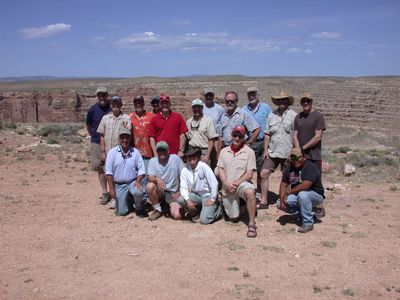Difference between revisions of "PEP reviews"
Cellsworth (Talk | contribs) |
Cellsworth (Talk | contribs) |
||
| (12 intermediate revisions by the same user not shown) | |||
| Line 17: | Line 17: | ||
</table> | </table> | ||
| + | [[File:PEP+biologists.JPG|400px]] | ||
<!-- | <!-- | ||
| Line 24: | Line 25: | ||
|style="width:100%; font-size:120%;"| | |style="width:100%; font-size:120%;"| | ||
| − | + | =='''Protocol Evaluation Panel (PEP) reviews'''== | |
| + | To acquire independent advice and critical input on proposed monitoring programs for each goal and associated | ||
| + | resources, the GCMRC periodically convenes a Protocol Evaluation Panel (PEP) to review the proposed | ||
| + | monitoring program. The PEP evaluates the results of the AMP information needs workshop, reviews results of | ||
| + | pilot monitoring efforts and relevant research and development activities, and recommends future monitoring | ||
| + | protocols and other technical specifications for the monitoring project. | ||
|}<!-- | |}<!-- | ||
| Line 37: | Line 43: | ||
|class="MainPageBG" style="width:55%; border:1px solid #cef2e0; background:#f5faff; vertical-align:top; color:#000;"| | |class="MainPageBG" style="width:55%; border:1px solid #cef2e0; background:#f5faff; vertical-align:top; color:#000;"| | ||
{|width="100%" cellpadding="2" cellspacing="5" style="vertical-align:top; background:#f5faff;" | {|width="100%" cellpadding="2" cellspacing="5" style="vertical-align:top; background:#f5faff;" | ||
| − | ! <h2 style="margin:0; background:#cedff2; font-size:120%; font-weight:bold; border:1px solid #a3bfb1; text-align:left; color:#000; padding:0.2em 0.4em;">Description of the Scientific Protocol Evaluation Panel (PEP) | + | ! <h2 style="margin:0; background:#cedff2; font-size:120%; font-weight:bold; border:1px solid #a3bfb1; text-align:left; color:#000; padding:0.2em 0.4em;">Description of the Scientific Protocol Evaluation Panel (PEP) Review Process [http://gcdamp.com/images_gcdamp_com/2/21/CoreMonitoringPlan_02-18-11_%281%29.pdf]</h2> |
| − | Review Process</h2> | + | |
|- | |- | ||
|style="color:#000;"| | |style="color:#000;"| | ||
| − | |||
| − | |||
| − | |||
| − | |||
| − | |||
| − | |||
The PEP external review panels are composed of subject experts derived from academia, independent research | The PEP external review panels are composed of subject experts derived from academia, independent research | ||
| Line 149: | Line 148: | ||
|style="color:#000;"| | |style="color:#000;"| | ||
| − | *[http://gcdamp.com/index.php?title= | + | *[http://gcdamp.com/index.php?title=2017_Water_Quality_PEP 2017 Water Quality PEP] |
| − | *[ | + | *[http://gcdamp.com/index.php?title=GCDAMP_2016_Fish_PEP 2016 Fish Monitoring Program PEP] |
| − | *[ | + | *[[2009 Fish Monitoring Program PEP]] |
| − | *[ | + | *[[2006 Physical Resources PEP]] |
| + | *[[Media:2005RecreationPEP.pdf| 2005 Recreation Monitoring Program PEP]] | ||
*[http://www.usbr.gov/uc/rm/amp/twg/mtgs/05may18/Attach_08a.pdf| 2004 Foodbase PEP] | *[http://www.usbr.gov/uc/rm/amp/twg/mtgs/05may18/Attach_08a.pdf| 2004 Foodbase PEP] | ||
| − | *[ | + | *[[Media:2001AquaticPEP.pdf | 2001 Aquatic PEP]] |
| − | *[ | + | *2000 Lees Ferry PEP |
| − | *[ | + | *[[Media:2000CulturalPEP.pdf| 2000 Cultural Resources Program PEP]] |
| + | *[[Media:1999SedimentPEP.pdf| 1999 Physical Resources PEP]] | ||
|- | |- | ||
| Line 165: | Line 166: | ||
|style="color:#000;"| | |style="color:#000;"| | ||
| − | *[[Core Monitoring Plan| Description of the Scientific Protocol Evaluation Panel (PEP) Review Process | + | *[[Core Monitoring Plan| Description of the Scientific Protocol Evaluation Panel (PEP) Review Process (Core Monitoring Plan, Appendix C)]] |
*[http://gcdamp.com/index.php?title=Portal:Desired_Future_Conditions_-DFCs 2012 Desired Future Conditions] | *[http://gcdamp.com/index.php?title=Portal:Desired_Future_Conditions_-DFCs 2012 Desired Future Conditions] | ||
*[[GCDAMP Planning| GCDAMP Monitoring and Research Planning Page]] | *[[GCDAMP Planning| GCDAMP Monitoring and Research Planning Page]] | ||
Latest revision as of 16:09, 20 November 2018
|
|
Protocol Evaluation Panel (PEP) reviewsTo acquire independent advice and critical input on proposed monitoring programs for each goal and associated resources, the GCMRC periodically convenes a Protocol Evaluation Panel (PEP) to review the proposed monitoring program. The PEP evaluates the results of the AMP information needs workshop, reviews results of pilot monitoring efforts and relevant research and development activities, and recommends future monitoring protocols and other technical specifications for the monitoring project. |
| -- | -- |
-- |
|---|
|
|
